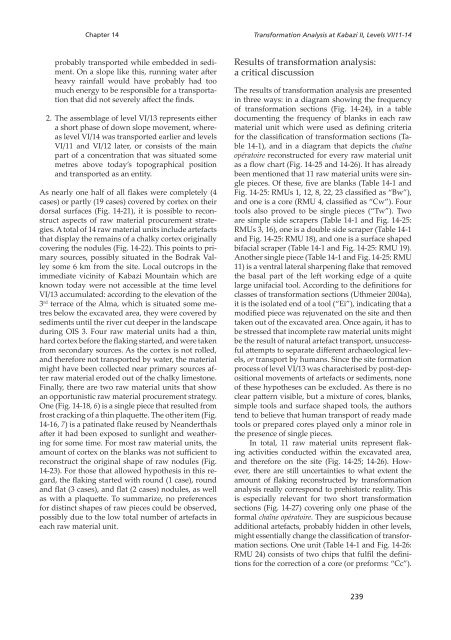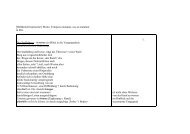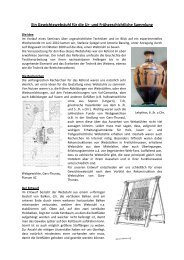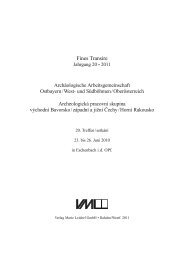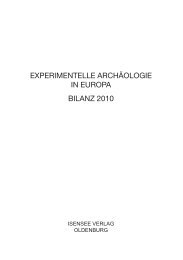Thorsten Uthmeier & Jürgen Richter
Thorsten Uthmeier & Jürgen Richter
Thorsten Uthmeier & Jürgen Richter
Create successful ePaper yourself
Turn your PDF publications into a flip-book with our unique Google optimized e-Paper software.
Chapter 14<br />
probably transported while embedded in sediment.<br />
On a slope like this, running water a�er<br />
heavy rainfall would have probably had too<br />
much energy to be responsible for a transportation<br />
that did not severely affect the finds.<br />
2. The assemblage of level VI/13 represents either<br />
a short phase of down slope movement, whereas<br />
level VI/14 was transported earlier and levels<br />
VI/11 and VI/12 later, or consists of the main<br />
part of a concentration that was situated some<br />
metres above today’s topographical position<br />
and transported as an entity.<br />
As nearly one half of all flakes were completely (4<br />
cases) or partly (19 cases) covered by cortex on their<br />
dorsal surfaces (Fig. 14-21), it is possible to reconstruct<br />
aspects of raw material procurement strategies.<br />
A total of 14 raw material units include artefacts<br />
that display the remains of a chalky cortex originally<br />
covering the nodules (Fig. 14-22). This points to primary<br />
sources, possibly situated in the Bodrak Valley<br />
some 6 km from the site. Local outcrops in the<br />
immediate vicinity of Kabazi Mountain which are<br />
known today were not accessible at the time level<br />
VI/13 accumulated: according to the elevation of the<br />
3 rd terrace of the Alma, which is situated some metres<br />
below the excavated area, they were covered by<br />
sediments until the river cut deeper in the landscape<br />
during OIS 3. Four raw material units had a thin,<br />
hard cortex before the flaking started, and were taken<br />
from secondary sources. As the cortex is not rolled,<br />
and therefore not transported by water, the material<br />
might have been collected near primary sources after<br />
raw material eroded out of the chalky limestone.<br />
Finally, there are two raw material units that show<br />
an opportunistic raw material procurement strategy.<br />
One (Fig. 14-18, 6) is a single piece that resulted from<br />
frost cracking of a thin plaque�e. The other item (Fig.<br />
14-16, 7) is a patinated flake reused by Neanderthals<br />
a�er it had been exposed to sunlight and weathering<br />
for some time. For most raw material units, the<br />
amount of cortex on the blanks was not sufficient to<br />
reconstruct the original shape of raw nodules (Fig.<br />
14-23). For those that allowed hypothesis in this regard,<br />
the flaking started with round (1 case), round<br />
and flat (3 cases), and flat (2 cases) nodules, as well<br />
as with a plaque�e. To summarize, no preferences<br />
for distinct shapes of raw pieces could be observed,<br />
possibly due to the low total number of artefacts in<br />
each raw material unit.<br />
Transformation Analysis at Kabazi II, Levels VI/11-14<br />
Results of transformation analysis:<br />
a critical discussion<br />
The results of transformation analysis are presented<br />
in three ways: in a diagram showing the frequency<br />
of transformation sections (Fig. 14-24), in a table<br />
documenting the frequency of blanks in each raw<br />
material unit which were used as defining criteria<br />
for the classification of transformation sections (Table<br />
14-1), and in a diagram that depicts the chaîne<br />
opératoire reconstructed for every raw material unit<br />
as a flow chart (Fig. 14-25 and 14-26). It has already<br />
been mentioned that 11 raw material units were single<br />
pieces. Of these, five are blanks (Table 14-1 and<br />
Fig. 14-25: RMUs 1, 12, 8, 22, 23 classified as “Bw”),<br />
and one is a core (RMU 4, classified as “Cw”). Four<br />
tools also proved to be single pieces (“Tw”). Two<br />
are simple side scrapers (Table 14-1 and Fig. 14-25:<br />
RMUs 3, 16), one is a double side scraper (Table 14-1<br />
and Fig. 14-25: RMU 18), and one is a surface shaped<br />
bifacial scraper (Table 14-1 and Fig. 14-25: RMU 19).<br />
Another single piece (Table 14-1 and Fig. 14-25: RMU<br />
11) is a ventral lateral sharpening flake that removed<br />
the basal part of the le� working edge of a quite<br />
large unifacial tool. According to the definitions for<br />
classes of transformation sections (<strong>Uthmeier</strong> 2004a),<br />
it is the isolated end of a tool (“Ei”), indicating that a<br />
modified piece was rejuvenated on the site and then<br />
taken out of the excavated area. Once again, it has to<br />
be stressed that incomplete raw material units might<br />
be the result of natural artefact transport, unsuccessful<br />
a�empts to separate different archaeological levels,<br />
or transport by humans. Since the site formation<br />
process of level VI/13 was characterised by post-depositional<br />
movements of artefacts or sediments, none<br />
of these hypotheses can be excluded. As there is no<br />
clear pa�ern visible, but a mixture of cores, blanks,<br />
simple tools and surface shaped tools, the authors<br />
tend to believe that human transport of ready made<br />
tools or prepared cores played only a minor role in<br />
the presence of single pieces.<br />
In total, 11 raw material units represent flaking<br />
activities conducted within the excavated area,<br />
and therefore on the site (Fig. 14-25; 14-26). However,<br />
there are still uncertainties to what extent the<br />
amount of flaking reconstructed by transformation<br />
analysis really correspond to prehistoric reality. This<br />
is especially relevant for two short transformation<br />
sections (Fig. 14-27) covering only one phase of the<br />
formal chaîne opératoire. They are suspicious because<br />
additional artefacts, probably hidden in other levels,<br />
might essentially change the classification of transformation<br />
sections. One unit (Table 14-1 and Fig. 14-26:<br />
RMU 24) consists of two chips that fulfil the definitions<br />
for the correction of a core (or preforms: “Cc”).<br />
239


